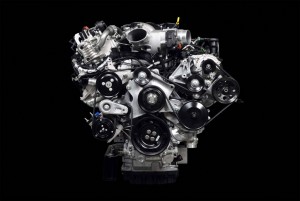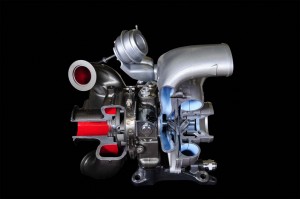
Ford developed its 2011 Power Stroke diesel in-house and expects "substantial" improvements in horsepower, torque and mileage.
Ford Motor Co. is ready to roll out the first diesel engine it has developed entirely in-house, a quiet, technically-sophisticated and high-mileage “oil-burner” that will replace the old Power Stroke diesel had been outsourcing.
The new 6.7-liter V8 will appear in Ford’s biggest, Super-Duty trucks, models like the F350, where buyers are seeking a mix of stump-pulling torque and high mileage. But the new diesel could very well be transformed into the fuel-efficient powertrain that many analysts believes the automaker needs in its light-duty F-150, as well.
So Ford officials confirm, but they quickly stress that there are no plans to launch an F-150 diesel, at least not until they can figure out a profitable business equation.
Known internally as Scorpion, the new V-8 is the result of a nearly 4-year development project that was handled much like some of the legendary Skunkworks programs at Lockheed – with developers moving away from the main Ford engineering campus in an effort to minimize the typical bureaucratic interference.

This Honeywell-patented sequential turbo is the key to delivering more power at lower RPMs, even while improving fuel economy.
What they’ve come up with looks – at least on paper and in a static display – to be a far cry from the diesel Super-Duty users are used to. Though the new oil-burner shares the name, it has absolutely nothing in common with the old engine, which is no surprise, considering the increased demands for fuel economy, as well as tightened emissions regulations.
To start with, Ford developers have turned to compacted graphite iron, rather than conventional cast iron, for the 6.7-liter engine’s block. The material is significantly stronger, but also quite a bit lighter – even with all the added technology needed to meet consumer demands and various government mandates, the 2011 Power Stroke comes in at 160 pounds under the old V-8 diesel.
With the official launch still a good year away, Ford’s PR department is carefully stage-managing the new diesel’s roll-out, holding back on critical information like power and mileage, but according to Lead Engineering Manager Adam Gryzlak, we’ve learned that it will deliver “substantially more” than the outgoing diesel’s 350 horsepower and 650 pound-feet of torque, with torque hitting peak at just 1600 RPM, compared to 2000 RPM for the old Power Stroke.
How does it get there? There are a variety of steps taken, beyond the use of compacted graphite iron, notably including a new Sequential Turbocharger that effectively functions as if it were a pair of turbos, as we’re seeing on a variety of new offerings. The system begins to kick in at low RPMs to bring torque on fast, then goes into full operation at higher speeds to boost horsepower. When power demands are low, it essentially idles, improving fuel economy.
The new diesel is a 32-valve Overhead-Valve, or OHV, design. That’s in contrast with the Overhead Cam, or OHC, diesels commonly used in passenger cars, especially in Europe, where oil-burners now account for about half of all motor vehicle sales. But the basic design, according to Gryglak, could lend itself to smaller, less complex and costly packages, such as might be needed in something like the F-150.
That’d be good news because in its new incarnation, we can expect to see a hefty premium for SuperDuty buyers. The current Power Stroke adds a whopping $7,800 to the price tag. In something more mainstream, says Ford’s truck marketing boss, Doug Scott, even a $4,000 to $5,000 premium would be hard to “pencil in” for most users.
The challenge is to come up with a premium that makes for a positive economic equation. With a vehicle like the F350, where fuel economy might drop as low as 5 to 8 mpg, when towing heavy loads, a diesel makes economic sense for those who plan to keep their vehicles as long as a decade. There’s not only the reduced fuel costs but the fact that diesels generally deliver better trade-in values.
But on smaller pickups, like the F-150, said Scott, it would likely require gas prices of around $4.00 a gallon – and diesel closer to $3.00 – to justify diesel’s premium.
On SuperDuty models, a positive cost/value equation is just one of the reasons why diesels have traditionally garnered about two-thirds of Ford truck sales. With the addition of the 2011 Power Stroke, the automaker hopes to further enhance the diesel’s appeal. Though we won’t expect a hands-on drive of the new engine until sometime in 2010, Ford gave a brief hint of some of its advantages in a test “mule.”
Standing anywhere nearby one of Ford’s old trucks can be a deafening experience, but the new model is surprisingly devoid of the traditional diesel clatter, thanks to a trio of tuned resonators designed to cancel out unpleasant sounds.
Another notable step will permit the new diesel to run on B20 bio-diesel, something many customers have been demanding. The old Power Stroke has suffered a variety of service problems when customers have used the fuel without official approval.
If Ford delivers as promised, it could increase demand for an expanded range of diesels. That is, of course, if lawmakers don’t wind up legislating the technology out of existence. A further crackdown on particulates, for example, “will make it a tougher row to hoe for diesels,” warns marketing manager Scott.
But there are those who believe that in the push to improve mileage and reduce CO2 emissions, diesels may still prove to be an effective technology that, like regulators in Europe have already discovered, American lawmakers may yet embrace.

The new 2011 Ford F-Series Super Duty is attractive model, it has got good features like its engine is equipped with a SCR system, numerous braking electronics, comfortable seating with heaters etc. To know more on 2011 Ford F-Series Super Duty features, performance, refer http://www.macktruck.org/2011-ford-f-series-super-duty.html
the new 2011 Ford F-Series Super-Duty trucks ramping up, the company has released the long awaited horsepower and torque ratings of its all new in-house designed V8 turbo diesel engine. The 2011 Ford F-Series Super Duty is all about meeting and exceeding customer demands across a wide range with the ‘and solution,’” said Scott. “Ford delivers best-in-class maximum capability and best-in-class fuel economy, with an average 18 percent improvement among diesel pickups and 25 percent improvement in diesel chassis cabs compared with 2010 models, and B20 compatibility.”
http://www.trucks4review.com/category/dodge